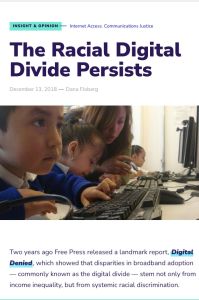Join getAbstract to access the summary!

Join getAbstract to access the summary!
Dana Floberg
The Racial Digital Divide Persists
FP, 2018
What's inside?
Address systemic racism to close the digital divide.
Recommendation
The report Digital Denied was released in 2016 and analyzed how racial discrimination impacts access to wired broadband internet services. While income is the largest factor, low-income households are disproportionately Black and Hispanic. Research into the “digital divide” favors analysis of the urban-rural divide. For racialized communities, barriers to home internet are higher costs and credit checks. The Federal Communications Commission (FCC) made the situation even worse by deregulating the industry to allow internet service providers (ISPs) to monopolize the market, reducing competition. Such systemic racism must be addressed to eliminate the digital divide.
Summary
About the Author
Dana Floberg is the associate director of broadband policy at Free Press.

















Comment on this summary